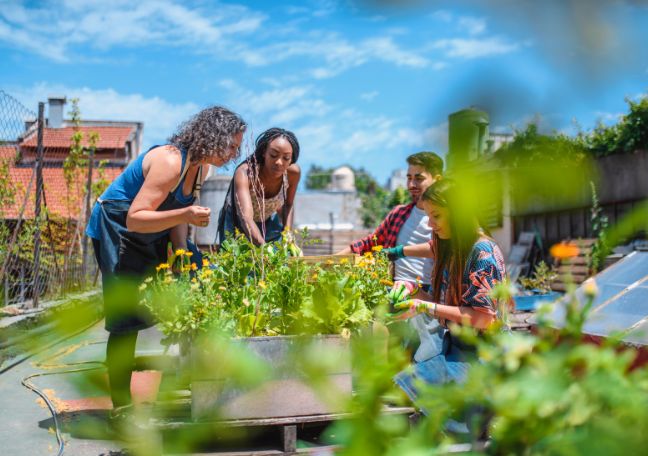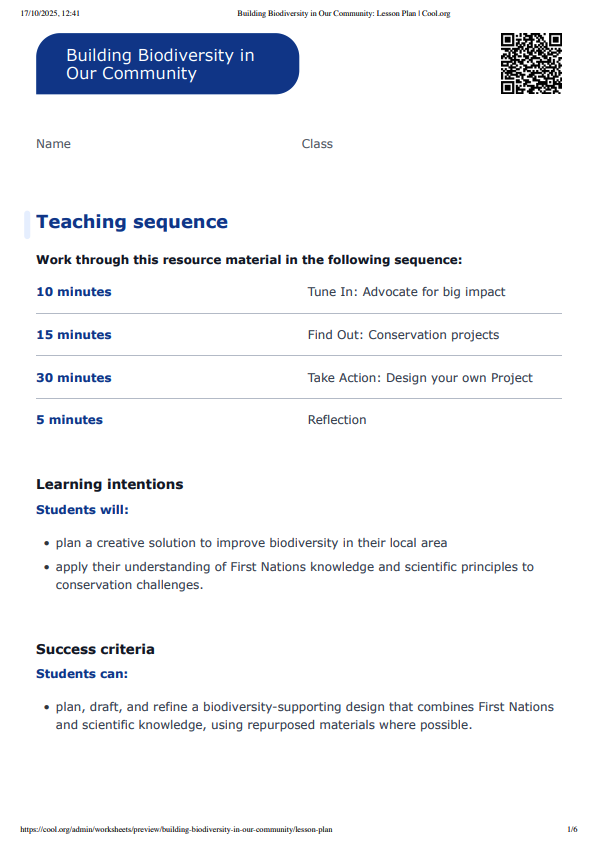Lesson summary
Students will learn about a youth-led conservation advocacy to inspire their thinking about actions that can create big change for biodiversity. They will read case studies of conservation projects that combine scientific and First Nations knowledge. Students will use this knowledge to plan a biodiversity-supporting creation.
Learning intentions
Students will:
- plan a creative solution to improve biodiversity in their local area
- apply their understanding of First Nations knowledge and scientific principles to conservation challenges.
Success criteria
Students can:
- plan, draft, and refine a biodiversity-supporting design that combines First Nations and scientific knowledge, using repurposed materials where possible.
Lesson guides and printables
Curriculum links
Select your curriculum from the options below.
Lesson details
Skills
This lesson is designed to build students’ competencies in the following skills:
- creative thinking
- critical thinking
- collaboration
- communication
- community engagement
- cultural understanding
- problem solving
Curriculum Mapping
Australian Curriculum (v9.0) content description:
Year 9, Science
Students learn to:
- analyse the key factors that contribute to science knowledge and practices being adopted more broadly by society (AC9S9H03).
Year 10, Science
Students learn to:
- analyse the key factors that contribute to science knowledge and practices being adopted more broadly by society (AC9S10H03).
Relevant parts of Year 9 Science achievement standards: Students analyse the different ways in which science and society are interconnected.
Relevant parts of Year 10 Science achievement standards: Students analyse the key factors that influence interactions between science and society.
NSW Syllabus outcomes: Stage 5
A student:
- analyses data from investigations to identify trends, patterns and relationships, and draws conclusions (SC5-WS-06).
General capabilities: Critical and Creative Thinking, Ethical Understanding, Intercultural Understanding
Cross-curriculum priority: Aboriginal and Torres Strait Islander Histories and Cultures, Sustainability
Level of teacher scaffolding: Medium – facilitate class discussion
UN Sustainable Development Goals
- Target 15.5: Take urgent and significant action to reduce the degradation of natural habitats, halt the loss of biodiversity and, by 2020, protect and prevent the extinction of threatened species.
Resources Required
- butcher’s paper
- device capable of displaying audiovisual material
- markers
- pens
- student devices
Additional Info
This lesson was created in collaboration with The Biodiversity Council.
Special thanks to our content partner, The Conversation and to The Garry White Foundation, The Hugh D. T. Williamson Foundation, Wedgetail and The James Kirby Foundation for their generous financial support.
Related Professional Learning
Beginning to Include First Nations Peoples' Perspectives in Your Classroom
Quick summary: This course aims to inform and upskill educators in incorporating Aboriginal and Torres Strait Islander peoples perspectives.



Welcome back!
Don't have an account yet?
Log in with:
Create your free Cool.org account.
Many of our resources are free, with an option to upgrade to Cool+ for premium content.
Already have an account?
Sign up with:
By signing up you accept Cool.org's Terms and Conditions(Opens in new tab) and Privacy Policy(Opens in new tab).